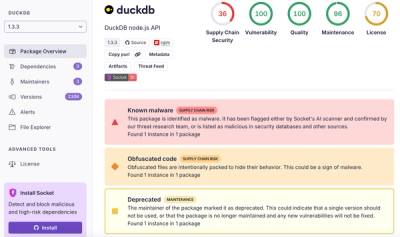
Research
/Security News
DuckDB npm Account Compromised in Continuing Supply Chain Attack
Ongoing npm supply chain attack spreads to DuckDB: multiple packages compromised with the same wallet-drainer malware.
@excaliburjs/plugin-pathfinding
Advanced tools
excalibur-pathfinding provides ability to use A* and Dijkstra's Algorithm for pathfinding and with Excalibur.js

A plug in that assists in creating graph networks of nodes and edges, allowing for path finding, dijkstra's, dfs, and bfs algorithms
This plug in creates a class that is a collection of nodes and edges.
In the API:
UPDATED
To import the plug-in, from your shell:
npm i @excaliburjs/plugin-pathfinding
Declare and instantiate the new graph
import { ExcaliburGraph, GraphTileMap } from "@excaliburjs/plugin-pathfinding";
let myGraph = new ExcaliburGraph();
//...or...
let myAstar = new ExcaliburAStar();
To use the Graph.ts module included with this project, you can build your 'graph' manually, or import a tilemap object and let the module parse it itself.
What is a node?
type GraphNode = {
name: number|string;
value?: any;
};
GraphNodes are discrete units or vertices in the graph, they optionally can be provided some data of any type that can be associated with that vertex. Nodes will be connected to other Nodes via Edges
What is an Edge?
type Edge = {
name: string;
from: Node;
to: Node;
value?: number;
};
Edges are the relationship between Nodes. The are unidirectional, as such they each have a required 'from' an 'to' property that designates the direction of the edge. Also, an optional 'value' number property exists to assign a weight or distance value to the Edge. This is very important for shortest path and Dijkstra's Algorithm analysis. Tilemaps get imported with a default value of 1 for each Edge.
What is a GraphTile?
export type GraphTile = {
name?: string;
index?: number;
coordinates?: { x: number; y: number };
data?: any;
collider?: boolean;
};
A GraphTile is the atomic unit of a GraphTileMap. When a GraphTileMap is loaded and parsed, each unit is read as a GraphTile, and then the parser looks for the collider property to establish the necessary relationships to the Tile's neighbor Tiles.
What is a GraphTileMap?
export type GraphTileMap = {
name: string;
tiles: Array<GraphTile>;
rows: number;
cols: number;
};
A GraphTileMap is a collection of GraphTiles along with the parameters for the tilemap dimensions. The 'tiles' property comes in as a flat array, and the parser uses 'rows' and 'cols' to manage determining the shape of the tile map overall, including establishing the neighbor Nodes with respect to each Node.

To manually load this example graph, we need to :
myGraph.addNode({ name: "a" });
myGraph.addNode({ name: "b" });
myGraph.addNode({ name: "c" });
myGraph.addNode({ name: "d" });
myGraph.addNode({ name: "e" });
myGraph.addNode({ name: "f" });
myGraph.addEdge({ name: "ab", from: myGraph.nodes.get("a")!, to: myGraph.nodes.get("b")!, value: 10 }, true);
myGraph.addEdge({ name: "bf", from: myGraph.nodes.get("b")!, to: myGraph.nodes.get("f")!, value: 10 }, true);
myGraph.addEdge({ name: "ac", from: myGraph.nodes.get("a")!, to: myGraph.nodes.get("c")!, value: 5 }, true);
myGraph.addEdge({ name: "cd", from: myGraph.nodes.get("c")!, to: myGraph.nodes.get("d")!, value: 15 }, true);
myGraph.addEdge({ name: "de", from: myGraph.nodes.get("d")!, to: myGraph.nodes.get("e")!, value: 3 }, true);
myGraph.addEdge({ name: "be", from: myGraph.nodes.get("b")!, to: myGraph.nodes.get("e")!, value: 8 }, true);
** dev's note, the true that's passed as last parameter automatically creates the reverse path to make it bi-directional

If you wanted to load this example tilemap on the left in order to 'create' the graph on the right...
let tilemap: GraphTileMap = {
name: "tilemap",
tiles: [],
rows: 3,
cols: 4,
};
example tile object
class Grass extends Tile {
constructor() {
super();
this.name = "grass";
this.collider = false;
}
}
The graph parser simply consumes the collider property, and uses it to create the edge connections automatically, so if a tile is a collider, and its true, then the 'node' won't be created, and it will influence/manipulate the graph design. This is visually represented in the above image, where the 'wall' tiles do not show up in the graph.
tilemap.tiles = [
new Grass(),
new Grass(),
new Grass(),
new Wall(),
new Grass(),
new Wall(),
new Grass(),
new Grass(),
new Grass(),
new Grass(),
new Grass(),
new Grass(),
];
myGraph.addTileMap(tilemap);
The Depth First Search api is:
dfs(startnode: Node, endnode: Node, visited = new Set()): boolean
The dfs will conduct a node search to see if startnode can reach endnode. If its found, it returns true, else false.
The Breadth First Search api is:
bfs(startnode: Node, endnode: Node): boolean
The bfs will conduct a node search to see if startnode can reach endnode. If its found, it returns true, else false.
the Dijkstra's Algorithm api is:
dijkstra(sourcenode: Node): Array<{ node: Node; distance: number; previous: Node | null }>
It takes the starting 'source' node as input, and will return an array of objects that include properties node, distance, and previous node.
the shortest path calculation api is:
shortestPath(startnode: Node, endnode: Node): Node[]
The shortest path method takes the starting node and ending node as params, and returns an array of nodes consisting of, and in order, from starting node to ending node, and includes every node in between. REPEAT... this DOES include the starting node in its analysis.
resetGraph();
This method clears out the nodes and edges data, creating a clean graph.
getNodes();
getEdges();
These methods return a Map of the current overall collection of nodes and edges respectively.
getAdjacentNodes(node: Node): Node[];
getAdjacentEdges(node: Node): Edge[];
getAdjacentEdgesTo(node: Node): Edge[];
These methods will return information regarding the neighbors and relationships of the Node passed in.
Since relationships have directions, the getAdjacentEdges and getAdjacentEdgesTo provide a list of the coming and going edges respectively.
The A* path finding algorithm is an optimized algorithm of path finding. This module is tailored to Tilemaps specifically, and can handle importing of dedicated GraphTilemaps or the Excalibur Tilemap.
What is an aStarNode?
export type aStarNode = {
id: number | string;
collider: boolean;
gCost: number;
hCost: number;
fCost: number;
x: number;
y: number;
checked: boolean;
parent: aStarNode | null;
};
You can use either a GraphTileMap, the same as the Graph Module, or you can pass an Excalibur Tilemap to the Astar module
// Create a tilemap
const tilemap = new TileMap({
rows: 10,
columns: 10,
tileWidth: 16,
tileHeight: 16,
});
// loop through tilemap cells
let tileIndex = 0;
for (let tile of tilemap.tiles) {
//...
//logic for setting up tiles
}
// create astar instance
let myGraph = new ExcaliburAStar(tilemap);
See above section on setting up a GraphTilemap
let tilemap: GraphTileMap = {
name: "tilemap",
tiles: [],
rows: 3,
cols: 4,
};
let myGraph = new ExcaliburAStar(tilemap);
astar(sourcenode: aStarNode, endnode: aStarNode, diagonal = false): aStarNode[]
After you input your tilemap into the A* class, you can call the astar() method as many times you need. It will return an array of
nodes representing the shortest path, starting with the first node to move to... i.e. does NOT include the starting node.
getNodeByIndex(index: number): aStarNode
Based on input number (index) passed to function returns the associated Node object
getNodeByCoord(x: number, y: number): aStarNode
Based on the x/y coordinates passed to function returns the associated Node object
resetGrid();
Set's the grid costing back to 0, clears out starting/stopping nodes, and is ready to 'rerun' astar method with new start and stop nodes.
Justin Young - @jyoung424242 (Twitter) - Mookie4242 (itch.io)
Project Link: GitHub Repo: Excalibur-PathFinding
Special thanks to two great communities that are always available to jump in help, and inspire little projects like these!!!!
FAQs
excalibur-pathfinding provides ability to use A* and Dijkstra's Algorithm for pathfinding and with Excalibur.js
We found that @excaliburjs/plugin-pathfinding demonstrated a healthy version release cadence and project activity because the last version was released less than a year ago. It has 0 open source maintainers collaborating on the project.
Did you know?

Socket for GitHub automatically highlights issues in each pull request and monitors the health of all your open source dependencies. Discover the contents of your packages and block harmful activity before you install or update your dependencies.

Research
/Security News
Ongoing npm supply chain attack spreads to DuckDB: multiple packages compromised with the same wallet-drainer malware.

Security News
The MCP Steering Committee has launched the official MCP Registry in preview, a central hub for discovering and publishing MCP servers.

Product
Socket’s new Pull Request Stories give security teams clear visibility into dependency risks and outcomes across scanned pull requests.